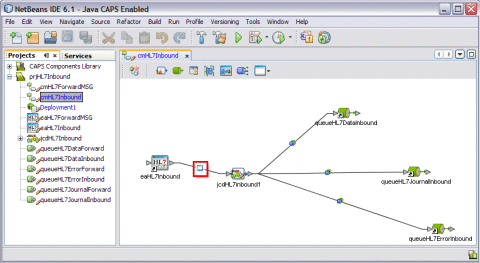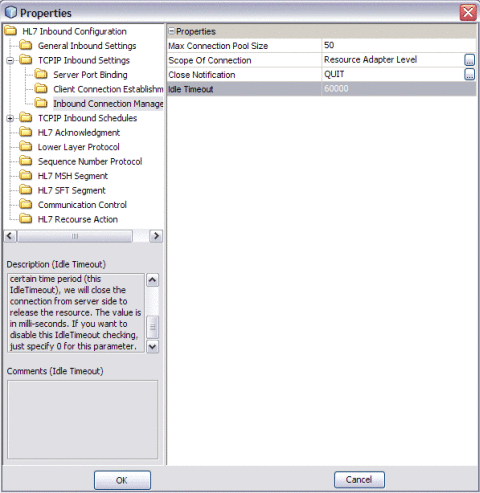Alert Type TCPIPBASE_SERVER_IDLE_TIMEOUT_EXPIRED
The HL7 adapter is enhanced to generate an alert when no messages are received from the HL7 client with in the configured idle time-out period (threshold).
-
A new alert type TCPIPBASE_SERVER_IDLE_TIMEOUT_EXPIRED has been added
-
This alert is generated on expiry of the time-out period specified in Connectivity Map property: HL7 Inbound Configuration --> TCPIP Inbound Settings --> Inbound Connection Management --> idle timeout
-
User must connect to the GlassFish Application Server to where the HL7 server application is deployed. View the alert from the eManage GUI.
 To Execute a Sample Project for the Alert Code
To Execute a Sample Project for the Alert Code
-
Install HL7eWay.sar file to Sun Java CAPS Repository.
-
Start the NetBeans IDE and install the HL7 adapter nbms to NetBeans IDE.
-
Re-start the NetBeans IDE and establish connection to the Sun Java CAPS Repository.
-
Import the sample HL7 project prjHL7Inbound.zip that is bundled with HL7eWay.sar into NetBeans IDE.

-
Double-click on the node to invoke the Configuration Properties.

-
Click OK.
-
Click prjHL7Inbound to build and deploy the project to the GlassFish Application Server.
-
Send messages to HL7 inbound project continuously from HL7 External System.
-
Start Java CAPS Enterprise Manager and install the HL7eWay emr from Java CAPS Repository to Enterprise Manager.
-
Connect to GlassFish Application Server where the project is deployed from Enterprise Manager.
-
Stop sending the message from HL7 External System.
Since there were no messages received from the HL7 External System within the configured idletimeout period, HL7 adapter will generate an alert.
-
Select the prjHL7Inbound/Deployment1/cmHL7Inbound/eaHL7Inbound external system from the explorer frame of the eManager GUI.
-
Select the Alerts link from the tree. An alert of type TCPIPBASE_SERVER_IDLE_TIMEOUT_EXPIRED is displayed in alerts table from the eaHL7Inbound=>jcdHL7inbound1 frame.
See Also
Message Code: TCPIPBASE-SERVER-IDLE-TIMEOUT-EXPIRED000008
Description: No message received from the peer within in the specified idle timeout value <60000>. So the connection with the peer is being terminated.
- © 2010, Oracle Corporation and/or its affiliates
